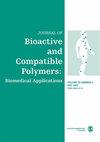天然催化剂在超声条件下与松香接枝的超支化聚缩水甘油:合成、表征和抗菌活性
IF 2.2
4区 生物学
Q3 BIOTECHNOLOGY & APPLIED MICROBIOLOGY
引用次数: 0
摘要
本研究旨在采用一种新型绿色聚合工艺,生产出一种具有潜在工业应用抗菌活性的新型共聚物。将缩水甘油聚合成超支化聚缩水甘油(HPG)聚合物,再将其与松香酯化,生产出新型共聚物--超支化共聚(缩水甘油-松香)(HPGR)。该工艺使用蒙脱石硅酸盐片状粘土 Maghnite-H+ 作为生态催化剂,并使用超声波增强聚合过程中的相互作用。测试了不同的催化剂用量,以评估它们对聚合过程的影响。傅立叶变换红外光谱法(FT-IR)、差示扫描量热法(DSC)和热重分析法(TGA)用于分析聚合物产品。采用琼脂盘扩散法评估了 HPGR 对六种人体标准微生物菌株的抗菌活性。催化剂比例为 10%时,HPGR 的产率最高(35%)。热重分析(TGA)显示,与 HPG 相比,HPGR 的热稳定性最好。HPGR 共聚物对肺炎克雷伯氏菌、蜡样芽孢杆菌、金黄色葡萄球菌和大肠杆菌的抗菌活性最佳,产生的抑菌区分别为 12.33 ± 0.57、11.00 ± 1.00、10.66 ± 1.15 和 10.33 ± 1.15 mm。这种由生态催化剂合成的超支化共聚物(缩水甘油-罗辛)具有有趣的物理和抗菌特性,可用于工业领域。本文章由计算机程序翻译,如有差异,请以英文原文为准。
Hyperbranched polyglycidol grafted with rosin by a natural catalyst under ultrasound: Synthesis, characterization and antimicrobial activity
This study aimed to apply a novel green polymerization process to produce a new copolymer with potential antimicrobial activity for industrial application. The glycidol was polymerized into hyperbranched polyglycidol (HPG) polymer which in turn has been esterified with rosin to produce hyperbranched copoly(glycidol-Rosin) (HPGR), a new co-polymer. The process used Maghnite-H+, a montmorillonite silicate sheet clay, as an eco-catalyst and ultrasound was applied to enhance the interaction during polymerization. Different catalyst amounts were tested to assess their effects on the polymerization process. Fourier Transform Infrared Spectroscopy (FT-IR), Differential Scanning Calorimetry (DSC) and Thermogravimetric Analysis (TGA) were used to analyze the polymer products. The antimicrobial activity of HPGR was assessed against six human standard microbial strains using the agar disc diffusion method. The catalyst percentage of 10% resulted in the best yield for HPGR (35%). Thermogravimetric Analysis (TGA) revealed a best thermal stability of HPGR compared to that of HPG. The HPGR co-polymer displayed the best antibacterial activity against Klebsiella pneumonia, Bacillus cereus, Staphylococcus aureus, and Escherichia coli, producing inhibition zones of 12.33 ± 0.57, 11.00 ± 1.00, 10.66 ± 1.15, and 10.33 ± 1.15 mm, respectively. The hyperbranched copoly(glycidol-Rosin), an eco-catalyst-synthesized co-polymer, displayed interesting physical and antimicrobial properties for industrial application.
求助全文
通过发布文献求助,成功后即可免费获取论文全文。
去求助
来源期刊

Journal of Bioactive and Compatible Polymers
工程技术-材料科学:生物材料
CiteScore
3.50
自引率
0.00%
发文量
27
审稿时长
2 months
期刊介绍:
The use and importance of biomedical polymers, especially in pharmacology, is growing rapidly. The Journal of Bioactive and Compatible Polymers is a fully peer-reviewed scholarly journal that provides biomedical polymer scientists and researchers with new information on important advances in this field. Examples of specific areas of interest to the journal include: polymeric drugs and drug design; polymeric functionalization and structures related to biological activity or compatibility; natural polymer modification to achieve specific biological activity or compatibility; enzyme modelling by polymers; membranes for biological use; liposome stabilization and cell modeling. This journal is a member of the Committee on Publication Ethics (COPE).
 求助内容:
求助内容: 应助结果提醒方式:
应助结果提醒方式:


